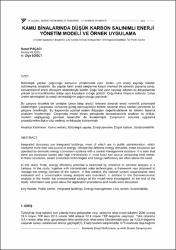| dc.contributor.author | Paçacı, İsmail | |
| dc.contributor.author | Ülgen, Koray | |
| dc.contributor.author | Söğüt, M. Ziya | |
| dc.date.accessioned | 2021-06-05T19:56:34Z | |
| dc.date.available | 2021-06-05T19:56:34Z | |
| dc.date.issued | 2020 | |
| dc.identifier.issn | 1300-3399 | |
| dc.identifier.issn | 2667-7555 | |
| dc.identifier.uri | https://app.trdizin.gov.tr/makale/TXpZeE5qSTVPUT09 | |
| dc.identifier.uri | https://hdl.handle.net/20.500.12960/308 | |
| dc.description.abstract | Bütünleşik yapılar, çoğunluğu kamunun yönetiminde olan, birden çok enerji kaynağı tüketen bütünleşmiş binalardır. Bu yapılar farklı enerji taleplerine karşın merkezi bir yönetim yapısına sahip, konvansiyonel enerji dönüşüm sistemleriyle işletilir. Çoğu fosil yakıt kaynağı tüketen ısı ihtiyaçlarında yüksek tersinmezliklerden dolayı aşırı kayıpların olduğu görülür. Çoğunlukla ihtiyacın üstünde, buhar üretim teknolojileri ile enerji verimsizliğinin yoğun olduğu yapılardır. Bu çalışma öncelikle bir yerleşke içinde talep analizi referans alınarak enerji verimlilik potansiyeli irdelenmiştir. Çalışmada, konsantre güneş teknolojileriyle birlikte, sistemin enerji talebini yönetecek bir çerçeve önerilmiştir. Bu kapsamda optimal sistem ihtiyaçları değerlendirilerek bir tüketim tasarruf analizleri incelenmiştir. Çalışmada model alınan yerleşkede termoekonomik analizler ile birlikte, modelin sağlayacağı çevresel tasarruflar da incelenmiştir. Çalışmanın sonunda uygulama prosedürlerine ilişkin bilgi verilmiş ve ihtiyaçlar irdelenmiştir. | en_US |
| dc.description.abstract | Integrated structures are integrated buildings, most of which are in public administration, which consume more than one source of energy. Despite the different energy demands, these structures are operated by domestic energy conversion systems with a central management structure. It is seen that there are excessive losses with high irreversibility in most fossil fuel source consuming heat needs. In these structures, steam production technologies and energy inefficiency are often above the need. In this study, firstly, energy efficiency potential is examined by reference to demand analysis in a campus. In the study, together with concentrated solar technologies, a framework was proposed to manage the energy demand of the system. In this context, the optimal system requirements were evaluated and a consumption saving analysis was examined. In addition to the thermoeconomic analysis in the model, the environmental savings of the model were investigated. At the end of the study, information was given about the application procedures and needs were discussed. | en_US |
| dc.language.iso | tur | en_US |
| dc.relation.ispartof | Tesisat Mühendisliği | en_US |
| dc.rights | info:eu-repo/semantics/openAccess | en_US |
| dc.subject | [No Keywords] | en_US |
| dc.title | Kamu Binalarında Düşük Karbon Salınımlı Enerji Yönetim Modeli ve Örnek Uygulama | en_US |
| dc.title.alternative | A Model Application Based on Low Carbon Energy Management of Integrated Buildings for Public Sector | en_US |
| dc.type | article | en_US |
| dc.department | İktisadi ve İdari Bilimler Fakültesi, Denizcilik İşletmeleri Yönetimi Bölümü | en_US |
| dc.department-temp | Ege universitesi, Gunes Enerjisi Enstitusu, Izmir, Turkiye;Ege universitesi, Gunes Enerjisi Enstitusu, Izmir, Turkiye;Piri Reis universitesi, Denizcilik Fakultesi, Istanbul, Turkiye | en_US |
| dc.contributor.institutionauthor | Söğüt, M. Ziya | |
| dc.identifier.volume | 2020 | en_US |
| dc.identifier.issue | 178 | en_US |
| dc.identifier.startpage | 67 | en_US |
| dc.identifier.endpage | 75 | en_US |
| dc.relation.publicationcategory | Makale - Ulusal Hakemli Dergi - Kurum Öğretim Elemanı | en_US |

















